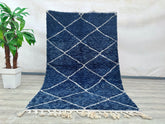Traditional and modern Berber carpets
Berber Carpets: Traditional Craftsmanship, Modern Appeal
Berber carpets embody an ancient tradition of intricate craftsmanship, symbolizing the rich cultural heritage of North Africa’s Berber communities. Handwoven by artisans who’ve passed down these skills through generations, these carpets tell stories through symbolic designs and durable materials. From traditional Beni Ouarain carpets with their classic black geometric patterns to colorful Azilal and Boucherouite rugs, Berber carpets serve as both practical home decor and cherished cultural artifacts.
Traditional Berber Rugs and Their Cultural Significance
Each Berber carpet carries unique symbolism that reflects Berber religion, beliefs, and traditions. Created with time-honored techniques, these rugs showcase geometric and symbolic designs that connect to spiritual and cultural stories. However, this cultural art form faces challenges due to the gradual shift from nomadic to more sedentary lifestyles among Berber tribes. In response, artisans today are blending new materials and designs with traditional weaving techniques to keep these heritage pieces alive.
Berber Rugs as a Part of the Bridal Dowry
In traditional Berber culture, carpets woven by young women were often included in bridal dowries. Families would keep these carpets for generations, as they held both financial and sentimental value. Today, Berber artisans continue to produce and sell rugs, often as a means to support their families during economic challenges, making these carpets a significant part of rural trade and community livelihood.
Distinctive Types of Berber Carpets: Beni Ouarain, Azilal, and Boucherouite
Berber wool carpets are best known for two iconic types: Beni Ouarain and Azilal rugs. Beni Ouarain carpets, with their thick wool and black geometric patterns on a white background, are renowned for their minimalist beauty and warmth. Azilal rugs, on the other hand, feature rich colors and intricate designs, bringing a lively element to any room. In contrast, Boucherouite rugs, which emerged in the mid-20th century, use recycled clothing instead of wool, offering a sustainable and affordable option for families with fewer resources.
Traditional and Modern Berber Rugs in North Africa
Today’s modern Berber carpets maintain the ringed pile characteristic of traditional weaving, with subtle, naturally toned backgrounds and small patches of darker shades. Unlike traditional rugs, modern Berber rugs often blend multiple colors without specific patterns, offering durability and cost-effectiveness. However, traditional handwoven Berber rugs stand out with their bold colors and unique knotting, distinguishing them from other Oriental carpets.
The Berber Rug Industry and the Role of Rural Artisans
Handcrafted Berber rugs remain a vital industry across North Africa. Many Berber families rely on making and selling these carpets in local markets to earn their primary income. These artisan-made rugs differ greatly from modern, mass-produced options, retaining the authenticity and craftsmanship valued by collectors and homeowners alike.
Materials Used in Modern Berber Carpets
While traditional Berber rugs were crafted from wool, modern versions incorporate materials like nylon, olefin fibers, and even hair. These materials enhance the rugs' resilience, making them an affordable choice that can adapt to both residential and commercial spaces.
Durability and Stain Resistance of Berber Carpets
One of the standout qualities of Berber carpets is their remarkable durability and stain resistance. With fibers that repel dirt and stains, Berber carpets are easy to maintain and perfect for high-traffic areas. For cleaning, experts recommend using low-humidity or dry-cleaning methods to prevent potential damage from high-alkaline steam cleaners, especially on olefin-based rugs. Regular deep cleaning every six to twelve months will help preserve the carpet's quality and appearance.
Conclusion
Berber carpets, with their timeless patterns and resilient craftsmanship, add warmth and style to any space. By choosing a Berber rug, you’re not only enhancing your decor but also supporting a rich cultural tradition and the artisans who keep it alive. From traditional patterns to modern, versatile designs, Berber carpets remain a favorite for anyone looking to add history, durability, and beauty to their home.
Featured Products
169 x 251 cm = 5.5 x 8.2 ft moroccan wool rug, moroccan style rug, bohemian rug, handmade rug, outdoor patio, beniourain Rug, decor rug, Handmade Gift
- $599.00
$1,830.00- $599.00
- (-67%)
- Unit price
- / per
155 x 247 cm = 5.1 x 8.1 ft Diamonds Blue Soft Dots Berber Runner Rug - Handmade Moroccan Wool, Minimalist Design, Vintage Style, Perfect for Weddings & Bohemian Decor
- $599.00
$1,830.00- $599.00
- (-67%)
- Unit price
- / per
- Authentic Moroccan rug
- Beni Ourain rug
- Beniouraincarpets
- Berber rug history
- Berber tribes
- Custom Area Rug
- Custom Beni Ourain Rug
- Diamond patterns rug
- Hand-woven rugs
- Handmade rug imperfections
- how to
- Modern Beni rugs
- modern moroccan rug
- Moroccan Berber rug
- Moroccan heritage
- Moroccan rug
- Moroccan rug authenticity
- Moroccan rug buying guide
- Natural fiber rugs
- Neutral hue rugs
- Plush texture rugs
- Rug craftsmanship
- Rug personalization
- soft moroccan rug
- Timeless rug designs
- Vintage Moroccan Rug
- warm rug
- White wool rug
- Wool Rug










